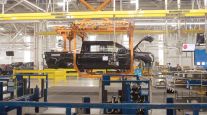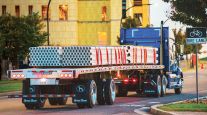Heavy-Duty Engine Makers Push 13-Liter Models
This story appears in the Dec. 5 print edition of Transport Topics.
Several heavy-duty truck manufacturers have succeeded in their drive to make 13-liter engines their new main on-highway power plant, according to R.L. Polk & Co. data, although some engine makers and fleets said 15-liter models will hold their own.
Fleets and owner-operators in the United States registered 40,935 new 13-liter engines in the first six months of this year, compared with 35,427 15-liter engines, Polk data prepared for Transport Topics show.
That increase reversed the pattern last year — 49,511 new 15-liter engines were registered throughout 2010, versus 32,220 13-liter engines, Polk said. The data also show that 15-liter engines were more popular than 13-liter engines from 2002 through 2010.
“At this point, the 13-liter has overtaken the 15-liter,” Gary Meteer Sr., account director at R.L. Polk, Southfield, Mich., told TT. “Given that four OEMs are pushing the 13-liter, we can assume it’s an early indication of a trend.”
Mack Trucks and Volvo Trucks said in October that their focus on 13-liter engines had made their joint sales the market leader in this weight class.
Navistar Inc., which makes International trucks, built its first heavy-duty engine plant in Huntsville, Ala., intending to put out only 11- and 13-liter models.
“We saw the industry shift to 13-liter power coming a long time ago and based our strategy on that premise,” Jack Allen, president of Navistar’s North American Truck Group, told TT.
“With more regionalized operations, shorter length of haul and changing freight dynamics, customers were looking for a lighter, more fuel-efficient engine, and our lightweight, fuel-efficient MaxxForce 13 engine is meeting that need today,” Allen said.
Navistar used the engine block and technology from European truck and engine company MAN SE for its 11-and 13-liter engines, although it also has added a big bore to its lineup.
“The shift to smaller displacement engines reflects both the advanced engine technology we have in the market today, as well as an increased customer focus on fuel efficiency,” David McKenna, Mack Trucks’ director of powertrain sales and marketing, told TT.
McKenna said engine makers now can get more power from smaller engines.
“Today,” he said, smaller engines are “fully electronically controlled, with sophisticated fuel and air management systems, not to mention superior metallurgy and improved engine lube oil.” Also, he said, Mack has raised the power density in those engines.
“The result is a reliable, 11-liter, 405-horsepower engine that’s up to 750 pounds lighter, or a 505-horsepower, 13-liter that’s about 450 pounds lighter, than today”s 15- and 16-liter platforms,” McKenna said.
Paccar Inc., which builds Peterbilt and Kenworth trucks, opened its first heavy-duty engine factory in Columbus, Miss., last year, making 9-liter and 13-liter engines. Paccar did not respond to requests for comment on its engines.
Fleets choosing to go with 13-liter models cited the economic advantages, while those keeping a majority of big-bore engines emphasized durability and the need for more power.
“We used to be 100% a big-bore company, but we’ve been changing that recently to where, by the end of this year, we’ll be 45% in the 13-liter range,” David Graham, vice president of maintenance at Paschall Truck Lines, Murray, Ky., told TT.
“We look at this as adding up to 800 more pounds of freight, because the smaller engines weigh 600 to 800 pounds less than a 15-liter,” Graham explained, saying the company eventually will phase out all 15-liter models.
Paschall Truck Lines ranks No. 87 on the Transport Topics Top 100 list of the largest U.S. and Canadian for-hire carriers.
“We’re converting our entire fleet of 240 tractors from 15-liters to 13-liters,” Daniel Cook, director of maintenance for over-the-road Danny Herman Trucking Inc., Mountain City, Tenn., told TT. “We ran tests before deciding. We’ve got 100 13-liters so far, and they’re operating great, at good fuel savings.”
But not all fleets make that choice, including such major carriers as Schneider National Inc. and FedEx Freight, and two major engine makers can supply them.
Elizabeth Rasberry, spokeswoman for UPS Inc., the largest fleet on the for-hire TT 100, said the company runs 11-liter engines as dual-use models.
“Most of the new dual-use engines purchased have been 11-liter,” Rasberry told TT. “We don’t release a breakdown of the complete numbers, but I can tell you that less than half the fleet is 15-liter.”
She did not say how many 13-liter engines the company currently uses but said the increase in horsepower and torque in 11-liter engines means “engine-size choices have changed in the last few years.”




